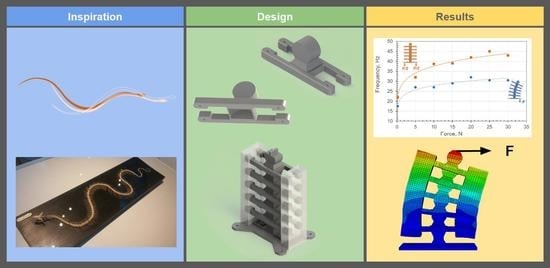Hybrid Compliant Musculoskeletal System for Fast Actuation in Robots
Abstract
1. Introduction
1.1. Nonlinear Hybrid Compliance
1.2. Musculoskeletal Energy Storage–Release
2. Design and Fabrication
3. Kinematics Development
4. Experimental Evaluation
4.1. Energy Storage Assessment
4.2. Energy Release Assessment
5. Mechanics of Elastic Energy Storage–Release
5.1. Elastic Storage in Hyperelastic Material
5.2. Energy Release in Undulation
6. Results and Discussion
6.1. Elastic Energy Storage
6.2. Elastic Energy Release
7. Conclusions
Supplementary Materials
Author Contributions
Funding
Data Availability Statement
Acknowledgments
Conflicts of Interest
References
- Whitesides, G.M. Soft robotics. Angew. Chem. Int. Ed. 2018, 57, 4258–4273. [Google Scholar] [CrossRef] [PubMed]
- Walker, J.; Zidek, T.; Harbel, C.; Yoon, S.; Strickland, F.S.; Kumar, S.; Shin, M. Soft robotics: A review of recent developments of pneumatic soft actuators. Actuators 2020, 9, 3. [Google Scholar] [CrossRef]
- Zhou, L.Y.; Fu, J.; He, Y. A review of 3D printing technologies for soft polymer materials. Adv. Funct. Mater. 2020, 30, 2000187. [Google Scholar] [CrossRef]
- Tawk, C.; Alici, G. A Review of 3D-Printable Soft Pneumatic Actuators and Sensors: Research Challenges and Opportunities. Adv. Intell. Syst. 2021, 3, 2000223. [Google Scholar] [CrossRef]
- Pal, A.; Restrepo, V.; Goswami, D.; Martinez, R.V. Exploiting mechanical instabilities in soft robotics: Control, sensing, and actuation. Adv. Mater. 2021, 33, 2006939. [Google Scholar] [CrossRef]
- Haghiashtiani, G.; Habtour, E.; Park, S.H.; Gardea, F.; McAlpine, M.C. 3D printed electrically-driven soft actuators. Extrem. Mech. Lett. 2018, 21, 1–8. [Google Scholar] [CrossRef] [PubMed]
- Qiu, Y.; Zhang, E.; Plamthottam, R.; Pei, Q. Dielectric elastomer artificial muscle: Materials innovations and device explorations. Acc. Chem. Res. 2019, 52, 316–325. [Google Scholar] [CrossRef] [PubMed]
- Branyan, C.; Hatton, R.L.; Mengüç, Y. Snake-Inspired Kirigami Skin for Lateral Undulation of a Soft Snake Robot. IEEE Robot. Autom. Lett. 2020, 5, 1728–1733. [Google Scholar] [CrossRef]
- Liu, Y.; Farimani, A.B. An Energy-Saving Snake Locomotion Gait Policy Using Deep Reinforcement Learning. arXiv 2021, arXiv:2103.04511. [Google Scholar]
- Hao, Z.; Song, S.; Li, B.; Jia, Q.X.; Zheng, T.; Zhang, Z. A Solvent Driven Dual Responsive Actuator based on MOF/Polymer Composite. Sens. Actuators B Chem. 2022, 358, 131448. [Google Scholar] [CrossRef]
- Sim, H.J.; Kim, J.; Choi, C. Biomimetic Self-Powered Artificial Muscle Using Tri-Functional Yarns that Combine Generator, Supercapacitor, and Actuator Functions. Sens. Actuators B Chem. 2022, 357, 131461. [Google Scholar] [CrossRef]
- Li, M.; Tang, Y.; Soon, R.H.; Dong, B.; Hu, W.; Sitti, M. Miniature coiled artificial muscle for wireless soft medical devices. Sci. Adv. 2022, 8, eabm5616. [Google Scholar] [CrossRef] [PubMed]
- Bai, R.; Yang, J.; Suo, Z. Fatigue of hydrogels. Eur. J. Mech. A Solids 2019, 74, 337–370. [Google Scholar] [CrossRef]
- Al-Rubaiai, M.; Pinto, T.; Qian, C.; Tan, X. Soft actuators with stiffness and shape modulation using 3D-printed conductive polylactic acid material. Soft Robot. 2019, 6, 318–332. [Google Scholar] [CrossRef] [PubMed]
- Zhu, J.; Lyu, L.; Xu, Y.; Liang, H.; Zhang, X.; Ding, H.; Wu, Z. Intelligent Soft Surgical Robots for Next-Generation Minimally Invasive Surgery. Adv. Intell. Syst. 2021, 3, 2100011. [Google Scholar] [CrossRef]
- Li, X.; Duan, H.; Lv, P.; Yi, X. Soft actuators based on liquid–vapor phase change composites. Soft Robot. 2021, 8, 251–261. [Google Scholar] [CrossRef]
- Xavier, M.S.; Fleming, A.J.; Yong, Y.K. Finite element modeling of soft fluidic actuators: Overview and recent developments. Adv. Intell. Syst. 2021, 3, 2000187. [Google Scholar] [CrossRef]
- Chung, H.J.; Parsons, A.M.; Zheng, L. Magnetically controlled soft robotics utilizing elastomers and gels in actuation: A review. Adv. Intell. Syst. 2021, 3, 2000186. [Google Scholar] [CrossRef]
- Zhang, Y.F.; Zhang, N.; Hingorani, H.; Ding, N.; Wang, D.; Yuan, C.; Zhang, B.; Gu, G.; Ge, Q. Fast-response, stiffness-tunable soft actuator by hybrid multimaterial 3D printing. Adv. Funct. Mater. 2019, 29, 1806698. [Google Scholar] [CrossRef]
- Nassour, J.; Zhao, G.; Grimmer, M. Soft pneumatic elbow exoskeleton reduces the muscle activity, metabolic cost and fatigue during holding and carrying of loads. Sci. Rep. 2021, 11, 12556. [Google Scholar] [CrossRef]
- Sun, J.; Zhang, D.; Zhang, Y.; Zhu, X.; Xi, J.; Zhang, Y.D. Research on performance of rigid-hoop-reinforced multi-DOF soft actuator. Adv. Mech. Eng. 2021, 13, 16878140211026718. [Google Scholar] [CrossRef]
- Jayne, B.C. What defines different modes of snake locomotion? Integr. Comp. Biol. 2020, 60, 156–170. [Google Scholar] [CrossRef] [PubMed]
- Seetohul, J.; Shafiee, M. Snake Robots for Surgical Applications: A Review. Robotics 2022, 11, 57. [Google Scholar]
- Li, X.; Ren, C.; Ma, S. Optimal Path Following Control With Efficient Computation for Snake Robots Subject to Multiple Constraints and Unknown Frictions. IEEE Robot. Autom. Lett. 2022, 7, 9151–9158. [Google Scholar] [CrossRef]
- Ramesh, D.; Fu, Q.; Li, C. SenSnake: A snake robot with contact force sensing for studying locomotion in complex 3-D terrain. In Proceedings of the 2022 International Conference on Robotics and Automation (ICRA), Philadelphia, PA, USA, 23–27 May 2022; pp. 2068–2075. [Google Scholar]
- Wang, C.; Puranam, V.R.; Misra, S.; Venkiteswaran, V.K. A Snake-Inspired Multi-Segmented Magnetic Soft Robot towards Medical Applications. IEEE Robot. Autom. Lett. 2022, 7, 5795–5802. [Google Scholar] [CrossRef]
- Feng, Y.; Siegmund, T.; Habtour, E.; Riddick, J. Impact Mechanics of Topologically Interlocked Material Assemblies. Int. J. Impact Eng. 2015, 75, 140–149. [Google Scholar] [CrossRef]
- Siegmund, T.; Barthelat, F.; Cipra, R.; Habtour, E.; Riddick, J. Manufacture and mechanics of topologically interlocked material assemblies. Appl. Mech. Rev. 2016, 68, 040803. [Google Scholar] [CrossRef]
- Jurestovsky, D.J.; Jayne, B.C.; Astley, H.C. Experimental modification of morphology reveals the effects of the zygosphene– zygantrum joint on the range of motion of snake vertebrae. J. Exp. Biol. 2020, 223, jeb216531. [Google Scholar] [CrossRef]
- Li, D.; Wang, C.; Deng, H.; Wei, Y. Motion Planning Algorithm of a Multi-Joint Snake-Like Robot Based on Improved Serpenoid Curve. IEEE Access 2020, 8, 8346–8360. [Google Scholar] [CrossRef]
- Virgala, I.; Kelemen, M.; Prada, E.; Sukop, M.; Kot, T.; Bobovský, Z.; Varga, M.; Ferenčík, P. A snake robot for locomotion in a pipe using trapezium-like travelling wave. Mech. Mach. Theory 2021, 158, 104221. [Google Scholar] [CrossRef]
- Bolmin, O.; Socha, J.J.; Alleyne, M.; Dunn, A.C.; Fezzaa, K.; Wissa, A.A. Nonlinear elasticity and damping govern ultrafast dynamics in click beetles. Proc. Natl. Acad. Sci. USA 2021, 118, e2014569118. [Google Scholar] [CrossRef] [PubMed]
- Han, B.; Ma, Z.C.; Zhang, Y.L.; Zhu, L.; Fan, H.; Bai, B.; Chen, Q.D.; Yang, G.Z.; Sun, H.B. Reprogrammable Soft Robot Actuation by Synergistic Magnetic and Light Fields. Adv. Funct. Mater. 2022, 32, 2110997. [Google Scholar] [CrossRef]
- Ruan, Y.; Zhang, M.; Kundrata, R.; Qiu, L.; Ge, S.; Yang, X.; Chen, X.; Jiang, S. Functional Morphology of the Thorax of the Click Beetle Campsosternus auratus (Coleoptera, Elateridae), with an Emphasis on Its Jumping Mechanism. Insects 2022, 13, 248. [Google Scholar] [CrossRef] [PubMed]
- Aliev, A.E.; Mayo, N.K.; Baughman, R.H.; Mills, B.T.; Habtour, E. Subwoofer and nanotube butterfly acoustic flame extinction. J. Phys. D Appl. Phys. 2017, 50, 29LT01. [Google Scholar] [CrossRef]
- Peele, B.; Li, S.; Larson, C.; Cortell, J.; Habtour, E.; Shepherd, R. Untethered stretchable displays for tactile interaction. Soft Robot. 2019, 6, 142–149. [Google Scholar] [CrossRef] [PubMed]
- Habtour, E.; Di Maio, D.; Masmeijer, T.; Cordova Gonzalez, L.; Tinga, T. Highly Sensitive Nonlinear Identification to Track Early Fatigue Signs in Flexible Structures. J. Nondestruct. Eval. Diagn. Progn. Eng. Syst. 2022, 5, 021005. [Google Scholar] [CrossRef]
- Bolmin, O.; Wei, L.; Hazel, A.M.; Dunn, A.C.; Wissa, A.; Alleyne, M. Latching of the click beetle (Coleoptera: Elateridae) thoracic hinge enabled by the morphology and mechanics of conformal structures. J. Exp. Biol. 2019, 222, jeb196683. [Google Scholar] [CrossRef]
- Yeaton, I.J.; Ross, S.D.; Baumgardner, G.A.; Socha, J.J. Undulation enables gliding in flying snakes. Nat. Phys. 2020, 16, 974–982. [Google Scholar] [CrossRef]
- Gerald, G.W. Effects of morphology, substrate use, and potential trade-offs on locomotor performance during multiple modes of snake locomotion. Evol. Ecol. Res. 2017, 18, 601–620. [Google Scholar]
- Chun, H.T.D.; Roberts, J.O.; Sayed, M.E.; Aracri, S.; Stokes, A.A. Towards more energy efficient pneumatic soft actuators using a port-hamiltonian approach. In Proceedings of the 2019 2nd IEEE International Conference on Soft Robotics (RoboSoft), Seoul, Korea, 14–18 April 2019; pp. 277–282. [Google Scholar]
- Chen, Y.; Yang, J.; Zhang, X.; Feng, Y.; Zeng, H.; Wang, L.; Feng, W. Light-driven bimorph soft actuators: Design, fabrication, and properties. Mater. Horiz. 2021, 8, 728–757. [Google Scholar] [CrossRef]
- Bell, M.A.; Gorissen, B.; Bertoldi, K.; Weaver, J.C.; Wood, R.J. A Modular and Self-Contained Fluidic Engine for Soft Actuators. Adv. Intell. Syst. 2022, 4, 2100094. [Google Scholar] [CrossRef]
- Eutionnat-Diffo, P.A.; Chen, Y.; Guan, J.; Cayla, A.; Campagne, C.; Zeng, X.; Nierstrasz, V. Stress, strain and deformation of poly-lactic acid filament deposited onto polyethylene terephthalate woven fabric through 3D printing process. Sci. Rep. 2019, 9, 14333. [Google Scholar] [CrossRef]
- Vasiliev, V.V.; Morozov, E.V. Advanced Mechanics of Composite Materials and Structural Elements; Elsevier: Amsterdam, The Netherlands, 2013. [Google Scholar]
- Owolabi, G.; Peterson, A.; Habtour, E.; Riddick, J.; Coatney, M.; Olasumboye, A.; Bolling, D. Dynamic response of acrylonitrile butadiene styrene under impact loading. Int. J. Mech. Mater. Eng. 2016, 11, 1–8. [Google Scholar] [CrossRef]
- Kim, Y.J.; Cheng, S.; Kim, S.; Iagnemma, K. A stiffness-adjustable hyperredundant manipulator using a variable neutral-line mechanism for minimally invasive surgery. IEEE Trans. Robot. 2014, 30, 382–395. [Google Scholar] [CrossRef]
- Melly, S.K.; Liu, L.; Liu, Y.; Leng, J. Improved Carroll’s hyperelastic model considering compressibility and its finite element implementation. Acta Mech. Sin. 2021, 37, 785–796. [Google Scholar] [CrossRef]
- Habtour, E.M.; Cole, D.P.; Kube, C.M.; Henry, T.C.; Haynes, R.A.; Gardea, F.; Sano, T.; Tinga, T. Structural state awareness through integration of global dynamic and local material behavior. J. Intell. Mater. Syst. Struct. 2019, 30, 1355–1365. [Google Scholar] [CrossRef]
- Ernst, M.; Habtour, E.; Dasgupta, A. Examining Steinberg’s Octave rule applicability for electronic systems exposed to multiaxial vibration. IEEE Trans. Compon. Packag. Manuf. Technol. 2016, 6, 561–568. [Google Scholar] [CrossRef]
- Habtour, E.; Paulus, M.; Dasgupta, A. Modeling approach for predicting the rate of frequency change of notched beam exposed to Gaussian random excitation. Shock Vib. 2014, 2014, 164039. [Google Scholar] [CrossRef]
- Rao, S.S. Vibration of Continuous Systems; John Wiley & Sons: Hoboken, NJ, USA, 2019. [Google Scholar]
- Paulus, M.; Dasgupta, A.; Habtour, E. Life estimation model of a cantilevered beam subjected to complex random vibration. Fatigue Fract. Eng. Mater. Struct. 2012, 35, 1058–1070. [Google Scholar] [CrossRef]
- Montoya, A.; Habtour, E.; Moreu, F. Quantifying Information without Entropy: Identifying Intermittent Disturbances in Dynamical Systems. Entropy 2020, 22, 1199. [Google Scholar] [CrossRef]
- Montoya, A.; Habtour, E.; Moreu, F. Detecting hidden transient events in noisy nonlinear time-series. Chaos Interdiscip. J. Nonlinear Sci. 2022, 32, 073131. [Google Scholar] [CrossRef] [PubMed]
- Habtour, E.; Sridharan, R.; Dasgupta, A.; Robeson, M.; Vantadori, S. Phase influence of combined rotational and transverse vibrations on the structural response. Mech. Syst. Signal Process. 2018, 100, 371–383. [Google Scholar] [CrossRef]
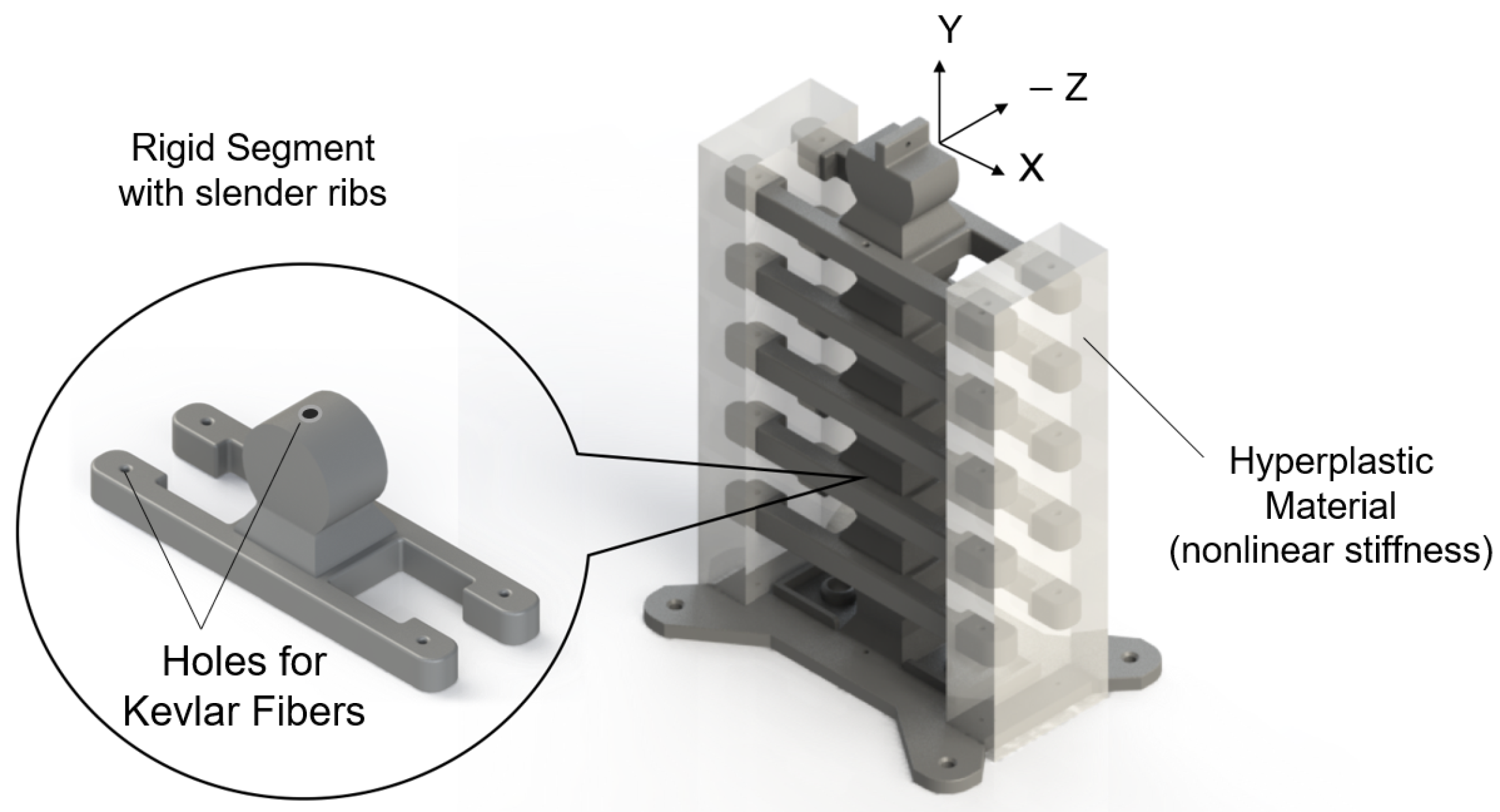
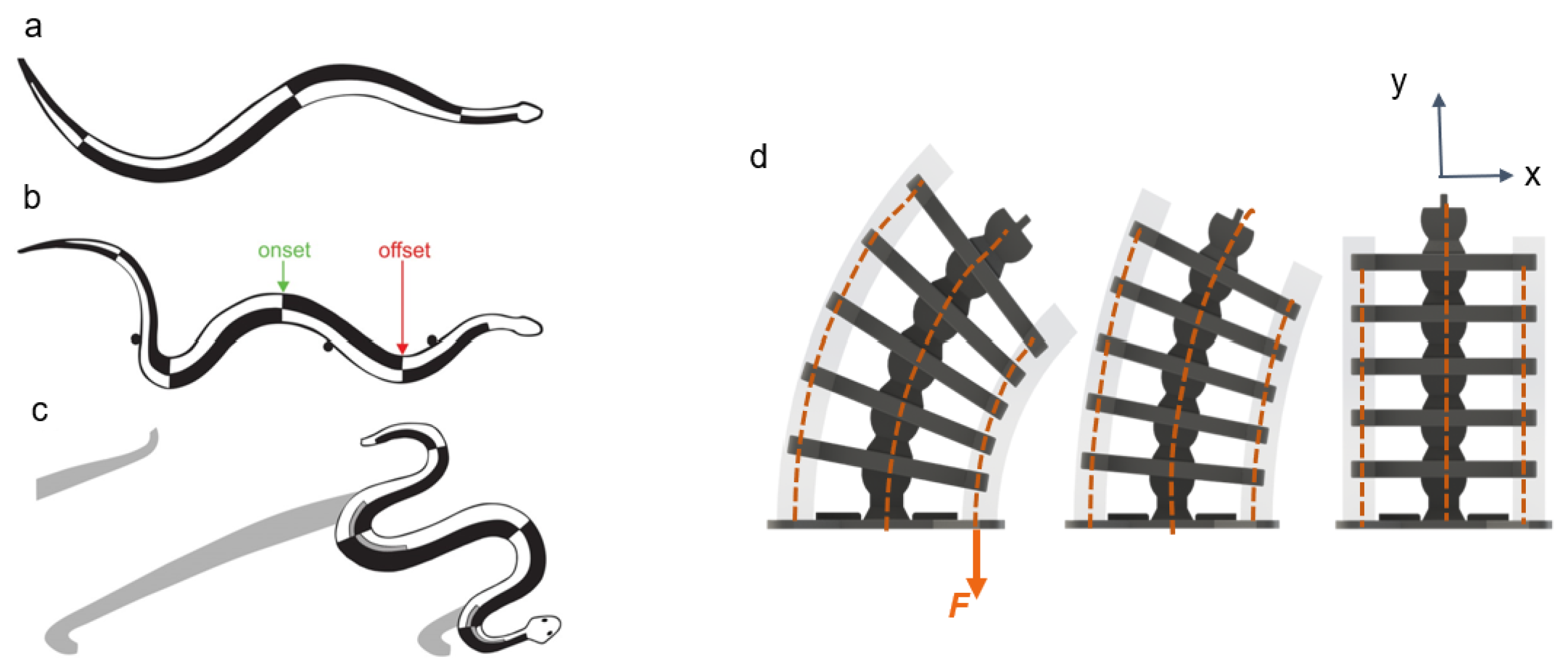
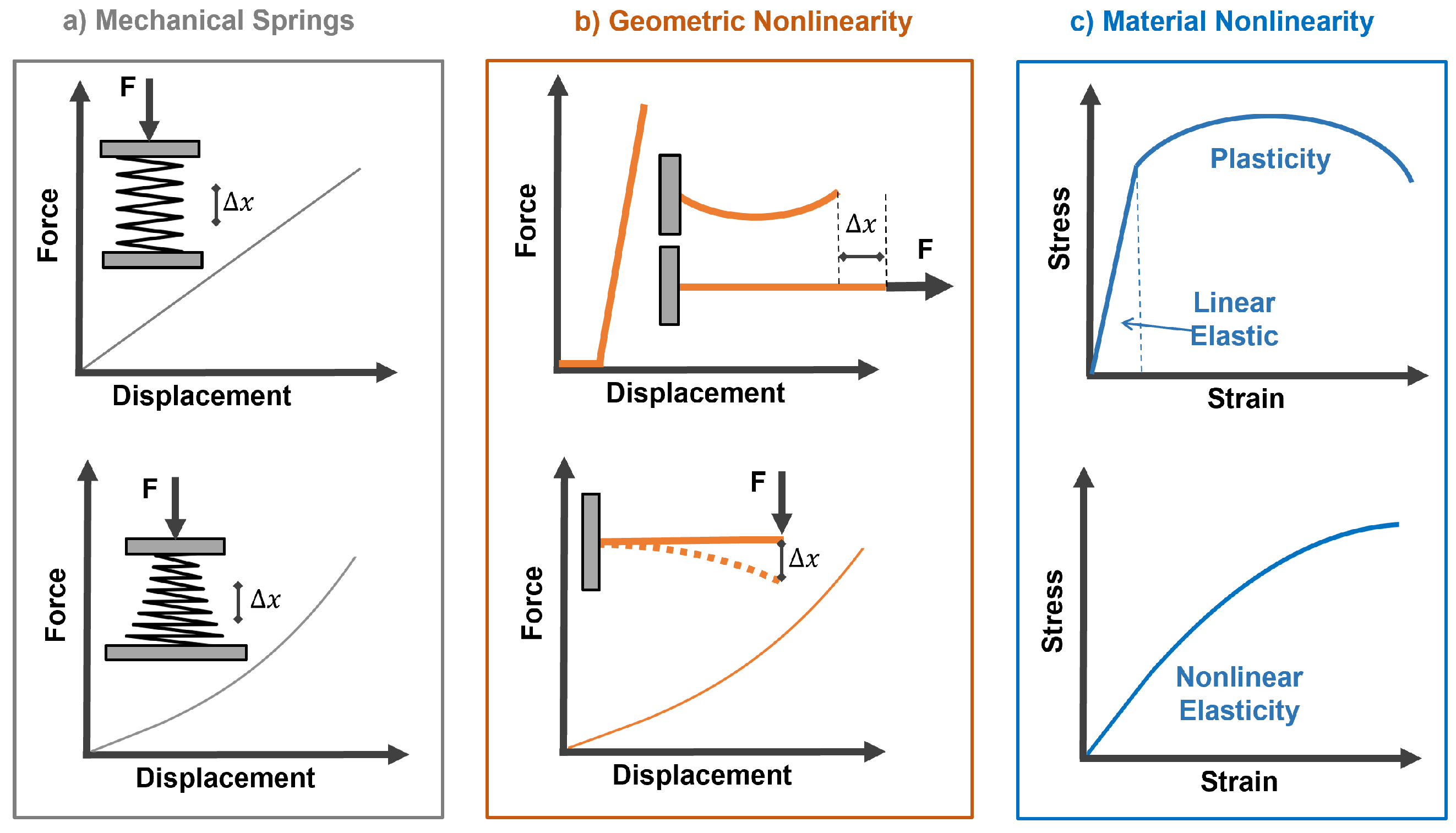
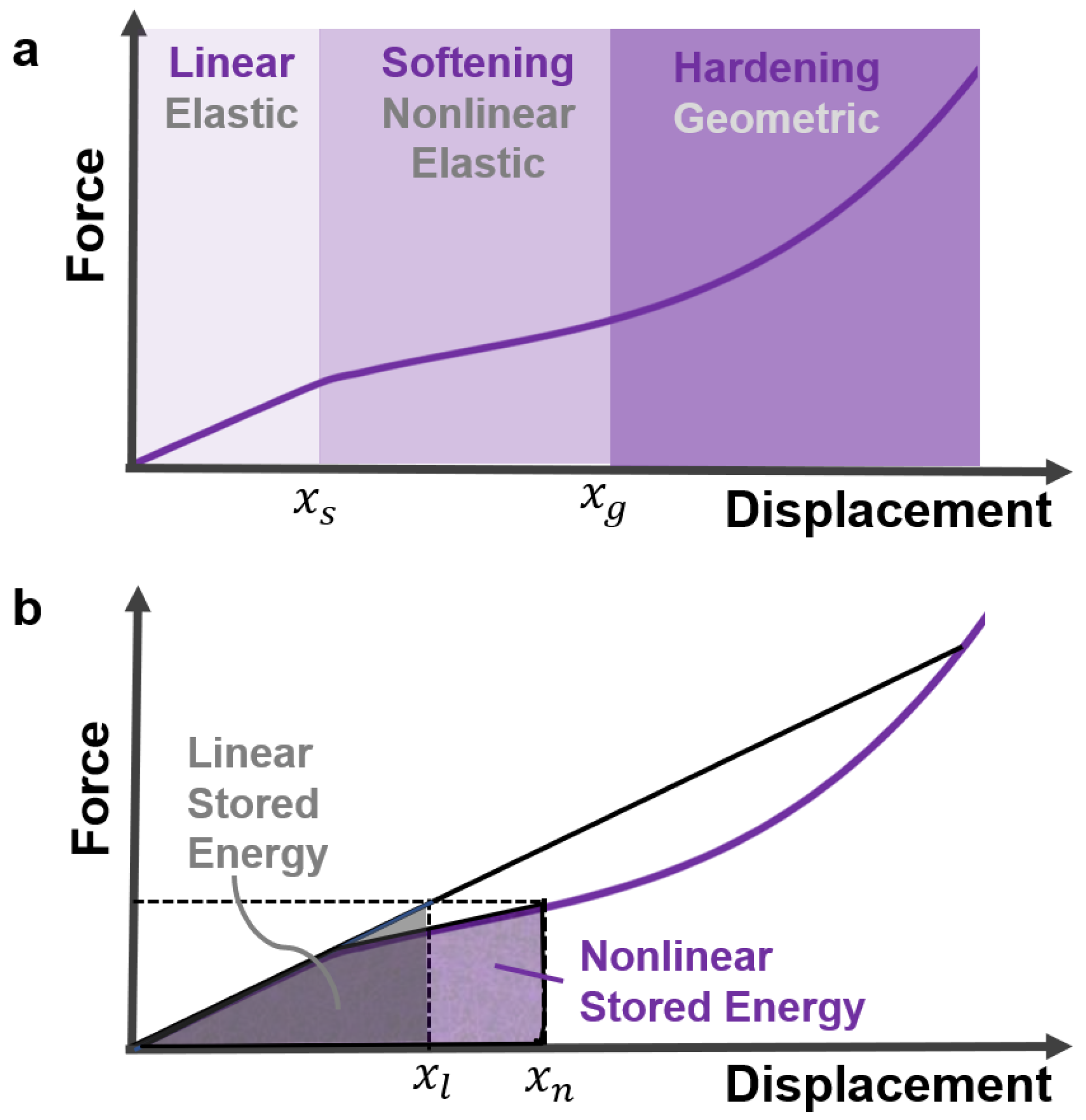

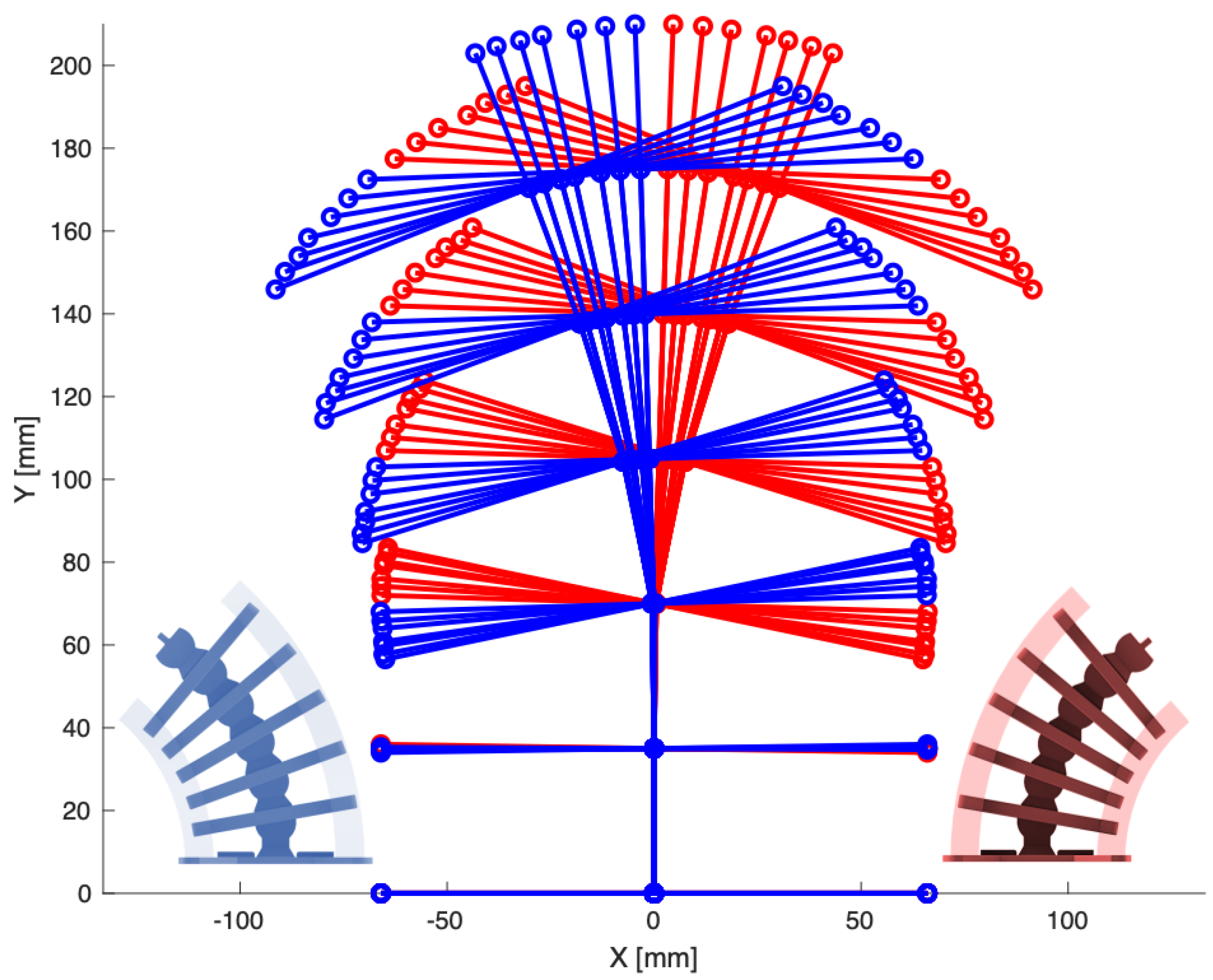




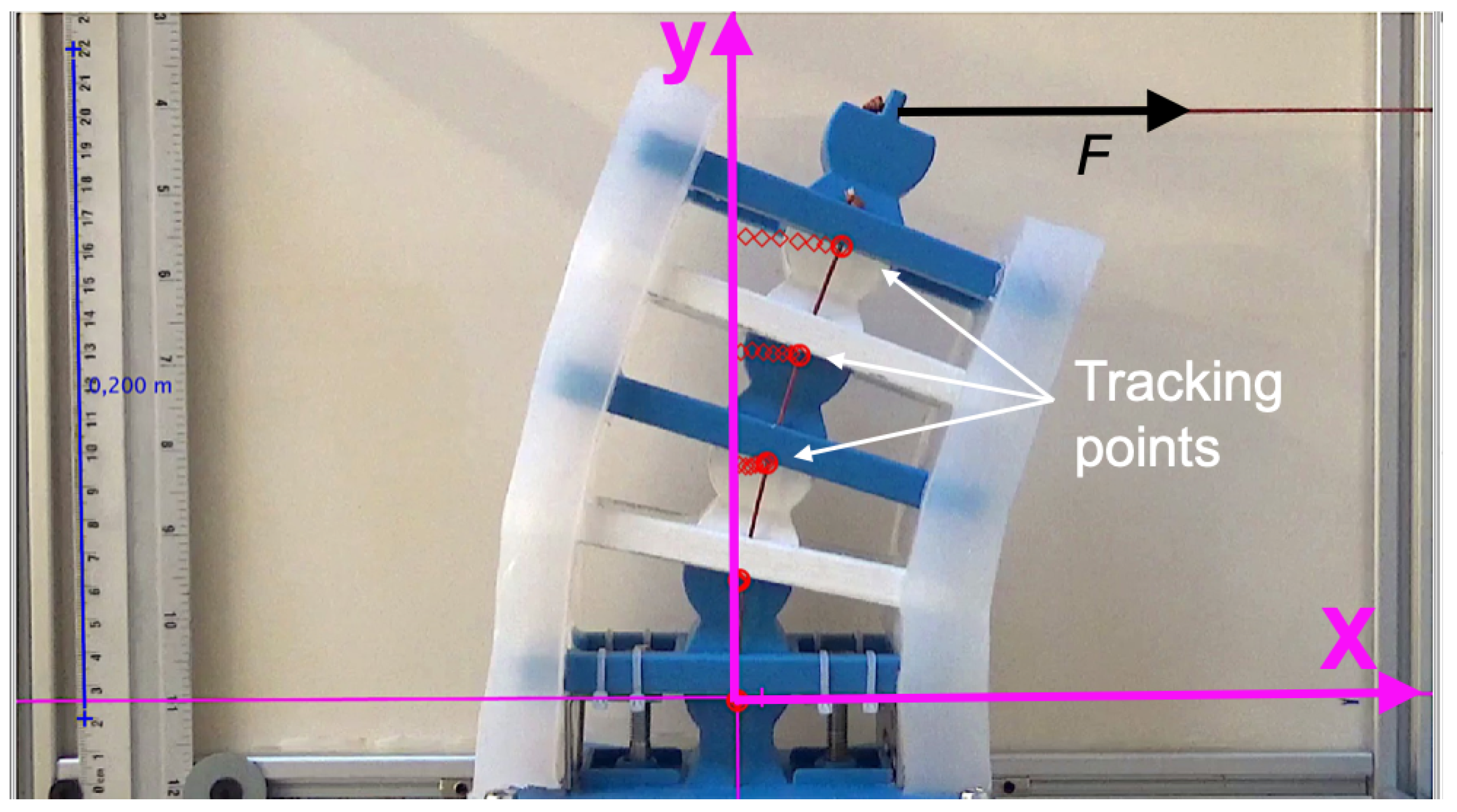


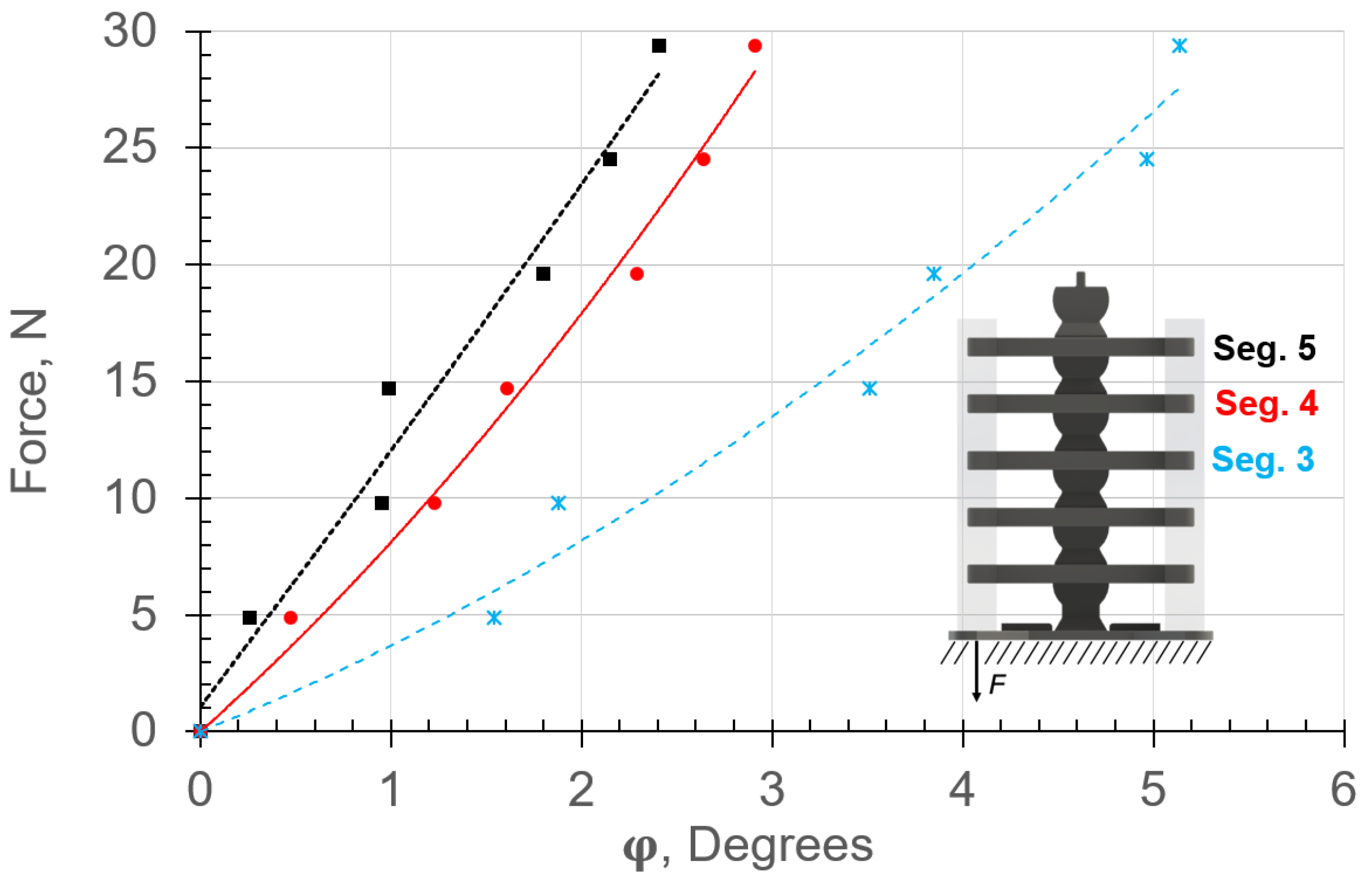



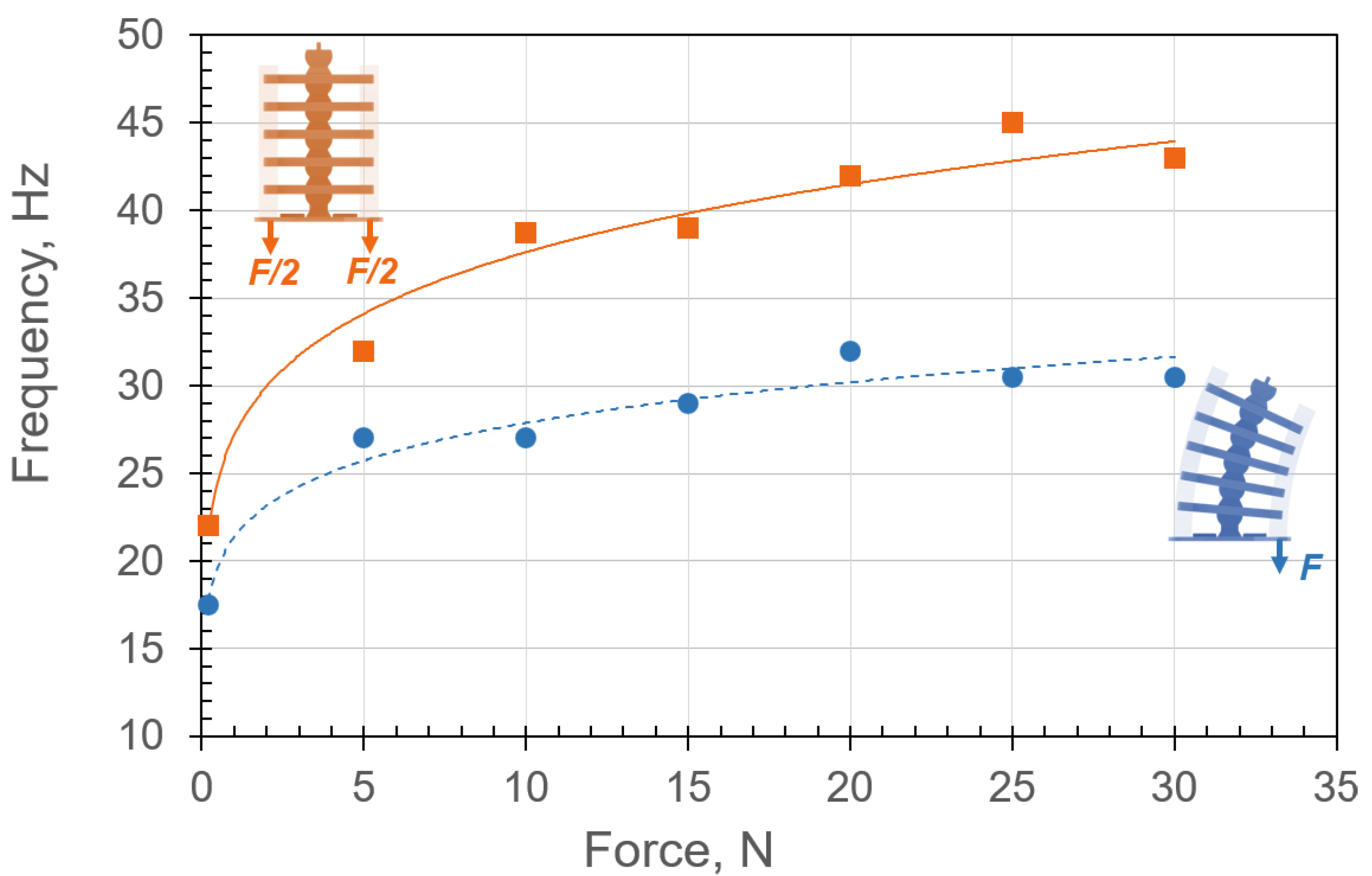
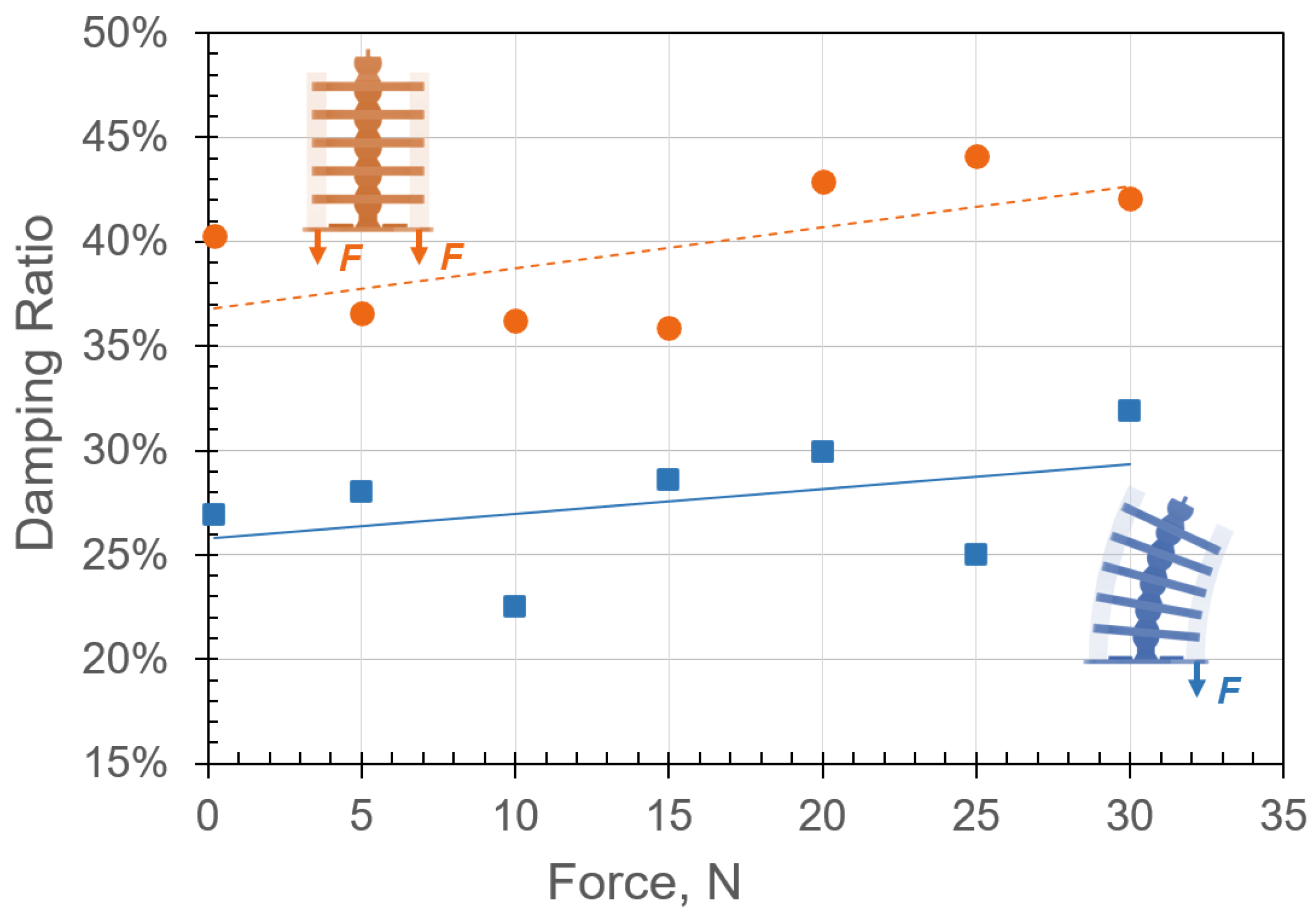
Publisher’s Note: MDPI stays neutral with regard to jurisdictional claims in published maps and institutional affiliations. |
© 2022 by the authors. Licensee MDPI, Basel, Switzerland. This article is an open access article distributed under the terms and conditions of the Creative Commons Attribution (CC BY) license (https://creativecommons.org/licenses/by/4.0/).
Share and Cite
Wiersinga, P.; Sleavin, A.; Boom, B.; Masmeijer, T.; Flint, S.; Habtour, E. Hybrid Compliant Musculoskeletal System for Fast Actuation in Robots. Micromachines 2022, 13, 1783. https://doi.org/10.3390/mi13101783
Wiersinga P, Sleavin A, Boom B, Masmeijer T, Flint S, Habtour E. Hybrid Compliant Musculoskeletal System for Fast Actuation in Robots. Micromachines. 2022; 13(10):1783. https://doi.org/10.3390/mi13101783
Chicago/Turabian StyleWiersinga, Pieter, Aidan Sleavin, Bart Boom, Thijs Masmeijer, Spencer Flint, and Ed Habtour. 2022. "Hybrid Compliant Musculoskeletal System for Fast Actuation in Robots" Micromachines 13, no. 10: 1783. https://doi.org/10.3390/mi13101783
APA StyleWiersinga, P., Sleavin, A., Boom, B., Masmeijer, T., Flint, S., & Habtour, E. (2022). Hybrid Compliant Musculoskeletal System for Fast Actuation in Robots. Micromachines, 13(10), 1783. https://doi.org/10.3390/mi13101783







